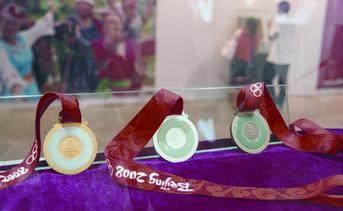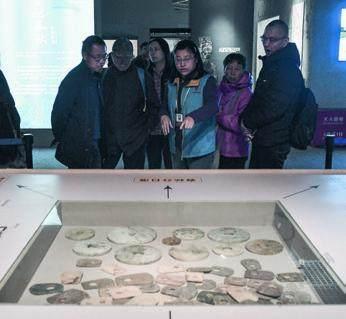A Capital Gem
2022-05-01ByDengDi
By Deng Di
As the old Chinese proverb goes,“For a man of true nobility, it is better to be a piece of broken jade than a whole tile,” meaning death in glory outdoes life in disgrace. In China, jade serves as one of the nation’s oldest symbols of virtue and nobility.
Considered the essence of Heaven and Earth, the material was used in the creation of sacrificial vessels for those of the uppermost social ranks across dynastical history.
Tough but tempered, beautiful but reserved; royals and nobility alike shared a proclivity for jade accessories and ornaments, given the status it denoted. A man of understated gentleness often is described as being mild and modest like jade, and yu ( “jade” in standard Chinese)—and characters including yu as a part of them—are often a popular choice when it comes to baby names.
According to archaeological findings, the Chinese began using jade during the Hongshan and Liangzhu cultures in the Neolithic period. Since then, jade crafters have produced stunning artworks, courtesy of their exquisite skills and intricate techniques passed down from generation to generation.
Among China’s wide-ranging styles of jade sculpting, Beijing’s is one of the most famous and recognized worldwide for its use of imperial elements.
Palace to people
Jade carving is a popular craft in the Chinese capital. It used to be reserved for the highest of social ranks, as jade was initially owned, for the most part, by the imperial family and nobility, with only a limited amount available to ordinary people. The famous jadeite napa cabbage in Taipei Palace Museum collection is a typical example of this art.
According to historical sources, the craft originated in the Yuan Dynasty(1279-1368), founded by Qiu Chuji, a prominent figure in Chinese Taoist history. In the succeeding dynasty, the Ming (1368-1644), the court ordered the establishment of a jade studio, gathering skilled jade carvers from all four corners of the nation to create the finest of products for the imperial family, lifting the art to new heights.
During the Qing Dynasty (1644-1911), jade became especially popular in Beijing, and the carving skill reached its peak. After the Qing, the craft continued to flourish, and the emergence of Pan Bingheng, Liu Deying, He Rong, Wang Shusen, among other prominent craftsmen launched the craft into the new era.
After the founding of the People’s Republic of China in 1949, Beijing’s jade carving industry grew exponentially, with thousands of artisans pouring their creativity into unique and newfangled designs. In 2008, Beijing’s particular practices were listed as national intangible cultural heritage.

Beijing jade wares are of rather sober demeanor, yet the application of geometric patterns and relief sculptural methods transformed their solemnness into artistically complex creations. The jade oeuvre at Beijing’s Palace Museum embodies the noble and elegant character of the capital city. Jade-carved animals and birds, in particular, are plump and sturdy, while the utensils also have a thicker appearance, occasionally embellished with flowers, twisted roots, and gnarled branches.
Beijing’s carving artisans use fine materials, like jades and jadites of different colors, and meticulous workmanship to produce a wide range of utensils and ornaments.
In the hands of skilled craftsmen, a raw jade piece goes through multiple processes en route to its fine art destination. These steps run from material selection, cleaning, cutting, designing and carving, all the way to the final polishing.
Throughout the process, there is one adage that should never be overlooked: Jade must be shaped according to its own particularities. Given the material’s texture differs from one piece to the other, the overall process is a matter of subtracting the unnecessary parts and preserving the essence, each step proving more crucial than the previous one. At times, the semi-finished product shows a complete departure from the original design.
Zhang Tiecheng is a third-generation Beijing jade carving inheritor. To this day, his art incorporates many an imperial component. “Jade carving is a process of repetition. Cutting and polishing a piece of jade is both time- and energy-consuming, but it’s all worth it when you see the final product,” he said.
Zhang vividly remembers the course of his crafting career. In 1983, when the technical school affiliated with the Beijing Jade Factory began to enroll students, Zhang decided to try his luck—despite a nonexistent knowledge of jade carving. He got in. After four years of training, he graduated and started working at the factory.

Upon graduation, Zhang noted, only six out of 30 students chose to remain in the jade trade. Through pure diligence and perseverance, he gradually rose through the ranks, and after years of hard work, became a master of the carving art.
The year 2008 was a significant one for Zhang. Beijing hosted the Olympic Summer Games, putting China in the global spotlight. Chinese jade art was also introduced internationally through the “Chinese Seal” Olympic emblem and the jade-encrusted medals. Zhang participated in the design of both.
“In Chinese culture, jade represents integrity, whereas gold represents wealth. We combined white jade with gold, a light greenish jade with silver, and a gray shade of jade with bronze to make the medals become that perfect blend of veracity and virtue.” According to Zhang, the medals were also highly resistant thanks to a special technique. “As athletes travel the world, jade will serve as a channel of China’s culture, going wherever those medals go.”
Following his Olympic stint, Zhang in 2010 was invited to restore the jade accessories and decorations in a Qing Dynasty garden in the Palace Museum. During this assignment, Zhang couldn’t help but feel sad as he realized how the once flourishing jade artistry was slowly vanishing from its once celebrated stage.
As an inheritor of Beijing jade carving, Zhang has incorporated modern aesthetic elements into the conception of this traditional skill. He now hopes more young people can take up the craftsmanship so it can continue to flourish for many years to come. BR
